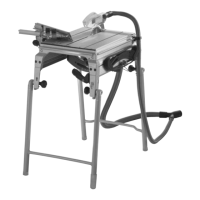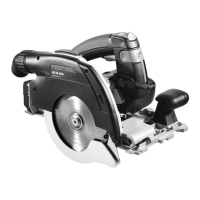- Replace a worn or damaged (e.g. bedded in)
tabletop immediately.
- Operating personnel must have received ade-
quate training in the use, set-up and operation
of the machine.
- Faults on the machine, including the separat-
ing guards or the tool, must be reported to
maintenance staff immediately upon discov-
ery. The machine must not be used until the
fault has been eliminated.
- Wear suitable personal protective equipment:
ear protection to reduce the risk of hearing
loss, safety goggles, a dust mask to prevent
inhalation of harmful dust, protective gloves
when working with raw materials and when
changing tools.
- To minimise noise, the tool must be sharpened
and all noise reducing elements (covers etc.)
must be properly adjusted.
- When cutting wood, connect the ma-
chine to a dust extractor corresponding to
EN 60335-2-69, dust category M.
- Never process material containing asbestos.
- Make sure that there is adequate lighting in
the room or workplace.
- Always assume the correct position before
starting work:
- front at the operating end,
- facing the machine,
- next to the cutting line.
- Use the accompanying workpiece holder to
guide the workpiece accurately past the saw
blade.
- Always use the supplied spacer wedge and
the guard. Ensure that they are set correct-
ly as described in the operating manual. An
incorrectly set spacer wedge and removing
components that are required for safety rea-
sons, such as the guards, can result in serious
injuries.
- Use a suitable device to support long work-
pieces and ensure that they are horizontal.
- Pull the plug from the main power socket be-
fore changing tools and rectifying faults such
as removing trapped splinters.
- Do not remove offcuts or other workpiece
parts from the cutting area while the tool is
still running and until the saw blade stops.
- If the saw blade is blocked, switch the machine
off immediately and disconnect the mains
plug. Do not remove the jammed workpiece
until you have done this.
- Cutting rebates or grooves is only permitted
with a suitable protective device fitted, e.g. a
protective tunnel over the saw table.
- You must re-install the safety equipment im-
mediately after work that requires the guard
to be removed, see sec. 6.1.
- Do not use circular saws for cutting slots
(grooves in workpiece).
- Before transporting the machine, make sure
that the top protective guard covers the top
section of the saw blade.
- Do not use the upper guard as a handle for
transportation!
- When not in use, store the push stick in the
holder provided on the machine.
- Only for AS/NZS: The tool shall always be sup-
plied via residual current device with a rated
residual current of 30 mA or less.
5.2 Emission levels
Noise emissions have been measured in accord-
ance with the specifications in EN 61029. These
specifications apply for operation as a trimming
saw and bench-mounted circular saw.
Noise level
Sound power level, idling 91 dB(A)
Sound power level,
during operation 103 dB(A)
Measuring uncertainty allowance K = 3 dB
Workplace emission levels
Workplace emission, idling 77 dB(A)
Workplace emission,
during operation 90 dB(A)
CAUTION
The noise produced during work may damage
your hearing.
fWear ear protection!
Measured acceleration < 2.5 m/s²
The specified emissions values (vibration, noise)
– are used to compare machines.
– They are also used for making preliminary
estimates regarding vibration and noise loads
during operation.
– They represent the primary applications of the
power tool.
Increase possible for other applications, with oth-
er insertion tools or if not maintained adequately.
Take note of idling and downtimes of machine!
16
PRECISIO

